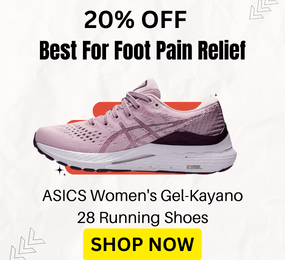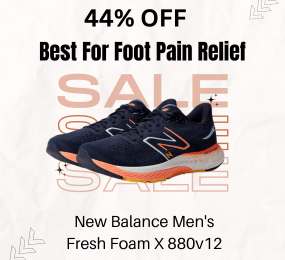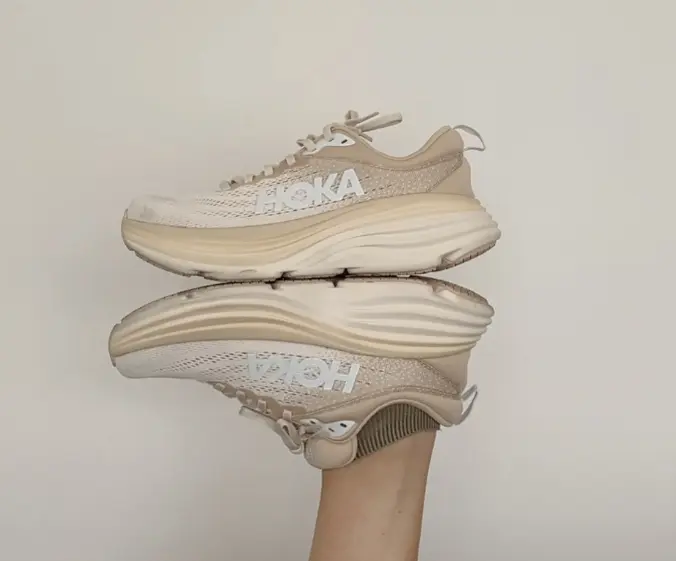Hoka shoes have been reported to causing foot pain in some wearers because of their thick cushioning, which can cause strain on the tendons and ligaments of the feet.

This issue is particularly common for runners with high arches or flat feet. To prevent this from happening, it’s important to wear running shoes that are designed for your specific arch type and ensure a proper fit by having them professionally fitted.

Hoka shoes have become increasingly popular in recent years due to their signature cushioning and lightweight design. However, some wearers of Hoka shoes have experienced pain in the feet as a result of this unique style. In this article, we will explore what might cause foot pain from Hoka shoes and provide solutions on how to reduce or eliminate any unpleasant sensations.

Do Hoka Shoes Hurt at First?
Although Hoka shoes are known for their distinctively thick and cushioned soles, so first-time users may feel a little bit of pain trying them for the first time. This is normal if you’re not used to wearing Hoka shoes. However, as your feet adjust to the cushioning and support of the shoes’ shape and design you will start to feel comfortable.
Before running or walking for a long period of time, wear them around the house for a short period. You want your foot arch muscles to adjust and adapt to the shoe so that you get used to it. In order to alleviate initial pressure points and reduce overall discomfort associated with wearing Hoka footwear, consider adding extra cushioning inside the shoe such as an over-the-counter supportive insole.
When you buy Hoka shoes in too small a size, you may get blisters, while if you choose a size that’s too big a size, you may end up suffering knee/hip/back pain after extended use – so make sure you’re properly sized before ordering.
3 Reasons Why Hoka Shoes May Hurt Your Feet?
Poorly Fitted Shoes
Hoka shoes may hurt your feet if they don’t fit right. This can manifest itself in several ways, from stitching that rubs against your foot to too-small sizes that squeeze or pinch too much. If you’re having trouble finding a pair of Hoka shoes that are sized correctly, it’s best to switch to another type of shoe altogether. This is because poor fitting footwear can cause blisters and other discomfort when worn for extended periods of time.
Unsupported Feet
Often, Hoka shoes don’t give you enough support, so that might be why they hurt your feet. Some models try to make up for it with extra cushioning, but they usually don’t compare to running or walking sneakers. These sneakers are designed to provide arch and heel support while allowing natural movement from heel strike to toe off.
Wrong Type/Style For Activity
The last common reason why Hoka shoes may be causing you pain in your feet is simply because they may not be suitable for the activity being performed at the time. It is important to keep in mind that distance running on asphalt roads and playing sports like soccer require additional stability in shoe choice selection processes than most typical Hokas (at least when compared side-by-side).).
Try to pick your shoes based on their purpose – so if you’re planning on jogging for a long time, then pick something with the most cushioning possible; but if you’re doing mainly light physical activities around the house, choose something that offers more support and stability instead of excess padding and shock absorption (which won’t really help unless you need it during exercise).
Prevention Tips to Avoid Foot Pain When Wearing Hoka Shoes
Wearing Hoka shoes can cause foot pain for new users, so here are a few tips to prevent it:
To ensure maximum comfort and support, make sure you buy the appropriate size. An ill-fitting shoe can result in blisters and discomfort for your feet.
Next, practice proper foot care and take breaks from wearing them if needed. You should take a break from wearing Hoka shoes if you feel any pain or discomfort. If you’re going running or walking long distances, cushioned insoles can be a helpful extra layer of protection.
As a final tip, always wear Hoka shoes with appropriate socks. Choose cotton or wool blend socks that will allow air to circulate around your foot, keeping it cool throughout the day and providing cushioning at the same time. In some cases, thick socks can cause friction against the shoe surface and cause painful blisters, so avoid them, as they may make your feet too warm or add too much bulk.
Best Insoles for Comfort While Wearing Hoka Shoes
Hoka shoes are designed to offer a comfortable running experience. However, there are still some people who experience foot pain after wearing Hoka shoes. The best solution is to use insoles designed for Hoka shoes to address this problem. With arch support and extra cushioning, these insoles can reduce foot pain and improve comfort.
Look for insoles for your Hoka shoes made with durable materials like foam or gel. A firm arch support insole will also allow you to control your foot motion while running and prevent overpronation and supination, both of which cause pain when running. Finally, you should consider choosing removable insoles because they are easier to clean and last longer than non-removable ones.
Professional Treatment Options For Chronic Foot Pain Related To Hokas
Many people experience chronic foot pain, which can range from mild discomfort to severe and debilitating pain that affects their daily lives. Fortunately, there are a number of professional treatment options available to help you deal with this issue.
For chronic foot pain resulting from Hokas, physical therapy is an effective treatment. Physical therapists use targeted exercises and stretches to strengthen your feet and reduce inflammation, helping alleviate your symptoms. The physical therapist can help you maintain proper movement patterns so that you do not exacerbate or create new issues.
If you wear Hoka shoes, orthotics may also help relieve chronic foot pain. Each individual’s orthotics are tailored to fit their arch shape and gait mechanics, providing extra support where needed while distributing pressure properly on their feet during walking and running.
Another option is chiropractic manipulation, which can help restore joint mobility and improve posture by releasing tight muscles around the joints of the lower extremities-namely around the ankle, knee, hip, and lower back regions-to align these areas so they work better together when you run or walk with Hoka shoes.
As well, foam rolling has been shown to reduce chronic foot pain associated with Hoka shoes. This is because it loosens up tight muscles that could be straining the surrounding bones and ligaments. In turn, this can cause more discomfort and complications if left untreated for too long.
Is plantar fasciitis caused by Hoka shoes?
Plantar fasciitis is a common and painful foot condition caused by inflammation in the plantar fascia, the connective tissue underneath your feet. Due to their thick soles and cushioning design, Hoka shoes can contribute to plantar fasciitis, although they’re not specifically known to cause it. With the extra padding, your feet may not absorb shock like they should, which can make plantar fasciitis more severe.
Incorrect fit or selection of shoe size can also lead to this problem — many people don’t take the increased thickness of Hoka shoes into account when they select sizes.
Having a poor fitting shoe also increases pressure on your heels and toes, which further strains your already weak plantar fascia ligaments. The right shoe should fit properly so you don’t rub too much pressure against your foot and provide enough support for you to wear it all day.
Last but not least, a poor warm-up before exercise will lead to severe plantar fasciitis pain in Hoka shoes – while static stretching exercises like calf raises prepare muscles for activity, they may not be adequate to protect against shock absorption issues caused by thick sole designs, such as those found in Hoka shoes. To prevent these problems, it is important to warm up well before exercising when you are wearing footwear like this.
Are Hoka shoes good for people with foot problems?
There is no simple answer to the question of whether Hoka shoes are suitable for people with foot problems. The cushioning in these shoes may help to reduce pressure on the feet when walking and running. However, if they aren’t fitted properly, they could also create additional pressure points.
To minimize the symptoms of foot pain caused by existing conditions such as bunions or plantar fasciitis and maximize comfort, choosing the right footwear is critical. You should also look for features like extra depth in the toe box and stability components that will provide support where needed as well as finding an appropriate size for your foot shape and width.
Since Hoka shoes offer enhanced cushioning compared to many similar athletic shoe styles on the market today, they can be beneficial to individuals with existing foot issues. When evaluating different models of Hoka shoes before making a purchase decision, it’s critical to consider how your condition affects the overall fit.
Why do podiatrists recommend Hoka Shoes?
Due to their design, Hoka shoes reduce the risk of injury and provide maximum comfort, which is why podiatrists recommend them highly. As a result of the unique cushioning in the sole, the foot is protected against common foot injuries, including plantar fasciitis, Achilles tendonitis, bunions and neuromas. This is due to exceptional support and shock absorption.
Designed with lightweight materials and a breathable fabric upper, these shoes make exercising easy for athletes. During workouts or races, the midsole foam provides an extra boost of energy.
Due to their stability features that aid with balance control when walking, podiatrists also recommend Hoka shoes for those suffering from chronic pain like arthritis or diabetes. Many of Hoka’s shoes are made without seams inside, so they won’t irritate anyone’s sensitive skin around the foot or toes.
Having Hoka shoes can help you stay active while preventing painful foot issues that can happen from regular athletic shoes not cushioning and supporting properly. Podiatric doctors recommend incorporating these types of shoes into your daily routine since they’re popular among athletes who want to perform better while protecting themselves from injuries.
What is the best Hoka shoe for plantar fasciitis and Flat Feet?
There is no doubt that Hoka shoes provide excellent cushioning, which is a particularly helpful feature for people suffering from plantar fasciitis or flat foot problems. The most suitable Hoka shoe for people suffering from plantar fasciitis and flat feet is the Bondi 7.
To reduce pressure on affected areas, this shoe has ample cushioning in the heel and forefoot. For long runs or walks, it provides a comfortable ride due to its generous amount of foam. An engineered mesh upper also provides breathability and a secure fit.
Because of its deep arch-supportive design and CMEVA cushioned midsole that absorbs shock when you step, the Bondi 7 is comfortable for people with flat feet too. Rocker geometry keeps your feet rolling smoothly so you don’t get painful pains if you hit your feet too hard.
Plus, with rubber pods strategically placed throughout the sole, it maximizes traction on wet surfaces and grip on slippery terrain such as grass and dirt paths. This makes it ideal for even more conditions typically unsuitable for traditional running shoes.
